Serving 2,892 students in grades 6-12, Basha High School ranks in the top 5% of all schools in Arizona for overall test scores (math proficiency is top 5%, and reading proficiency is top 5%).
The percentage of students achieving proficiency in math is 75% (which is higher than the Arizona state average of 35%). The percentage of students achieving proficiency in reading/language arts is 74% (which is higher than the Arizona state average of 40%).
The student:teacher ratio of 20:1 is higher than the Arizona state level of 17:1.
Minority enrollment is 42% of the student body (majority Hispanic and Asian), which is lower than the Arizona state average of 66% (majority Hispanic).
Quick Stats (2025)
- Grades: 6-12
- Enrollment: 2,892 students
- Student:Teacher Ratio: 20:1
- Minority Enrollment: 42%
- Graduation Rate: 93% (Top 20% in AZ)
- Overall Testing Rank: Top 5%
- Math Proficiency: 75% (Top 5%)
- Reading Proficiency: 74% (Top 5%)
- Science Proficiency: 36% (Top 30%)
- Source: National Center for Education Statistics (NCES), AZ Dept. of Education
Top Rankings
Basha High School ranks among the top 20% of public schools in Arizona for:
Category
Attribute
Overall Rank
Math Proficiency
Reading/Language Arts Proficiency
Graduation Rate
School Overview
Basha High School's student population of 2,892 students has grown by 16% over five school years.
The teacher population of 147 teachers has grown by 14% over five school years.
Grades Offered
Grades 6-12
Total Students
2,892 students
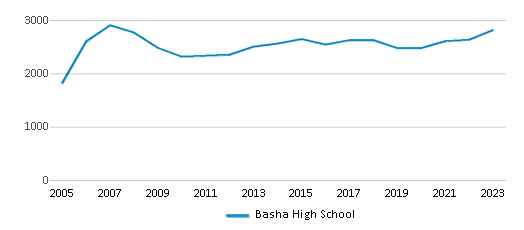
Gender %
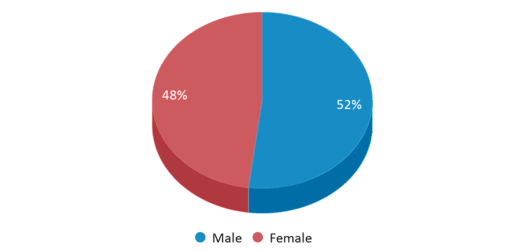
Total Classroom Teachers
147 teachers

Students by Grade
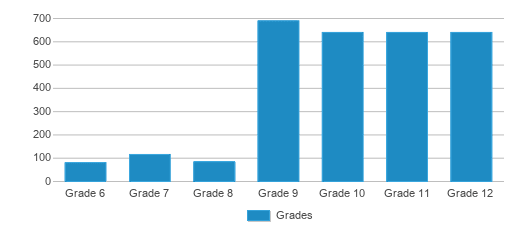
School Rankings
Basha High School ranks within the top 5% of all 1,956 schools in Arizona (based off of combined math and reading proficiency testing data).
The diversity score of Basha High School is 0.62, which is less than the diversity score at state average of 0.66. The school's diversity has stayed relatively flat over five school years.
Overall Testing Rank
#56 out of 1956 schools
(Top 5%)
(Top 5%)
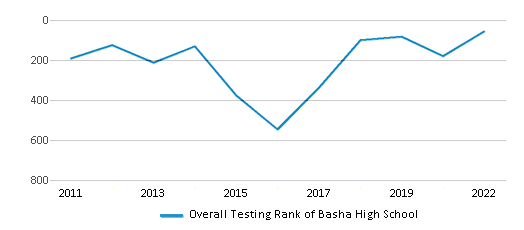
Math Test Scores (% Proficient)
75%
35%
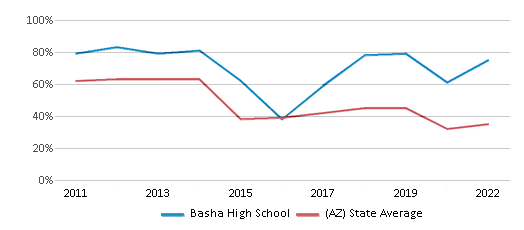
Reading/Language Arts Test Scores (% Proficient)
74%
40%
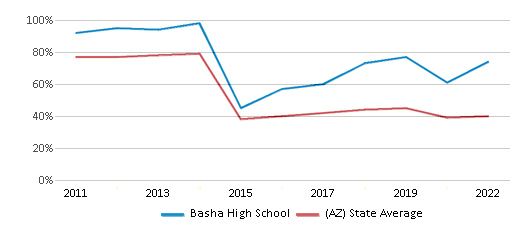
Science Test Scores (% Proficient)
36%
24%
Student : Teacher Ratio
20:1
17:1

American Indian
1%
5%
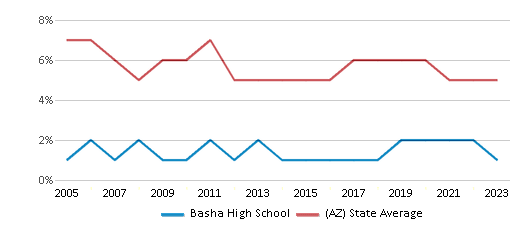
Asian
12%
3%
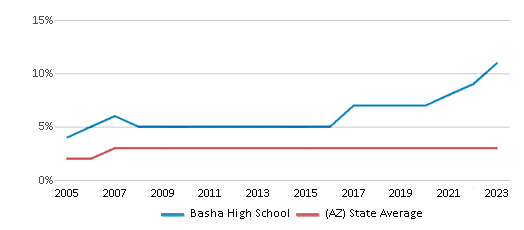
Hispanic
18%
48%
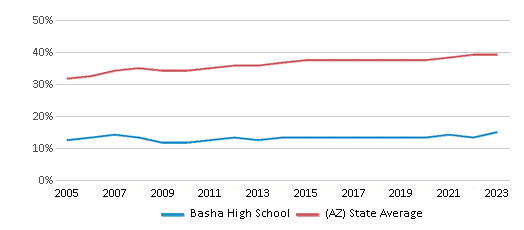
Black
5%
6%
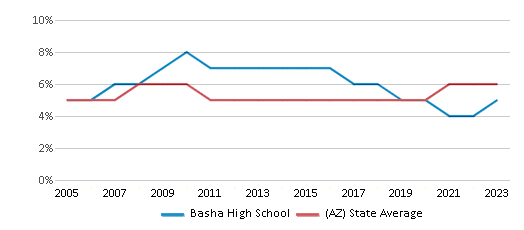
White
58%
34%
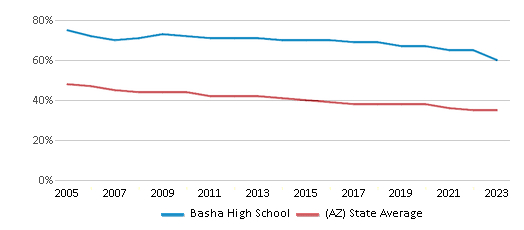
Hawaiian
n/a
n/a
Two or more races
6%
4%
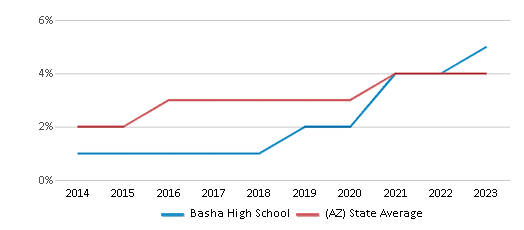
All Ethnic Groups
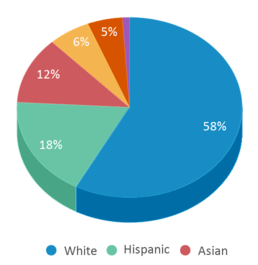
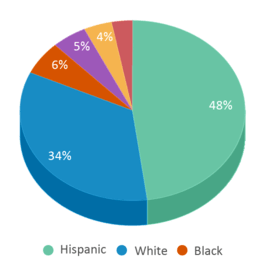
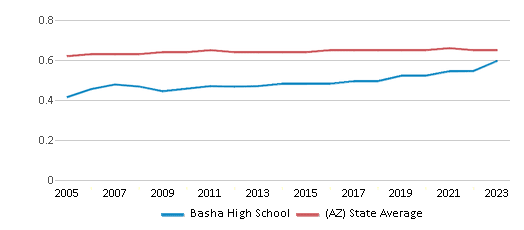
Graduation Rate
93%
77%
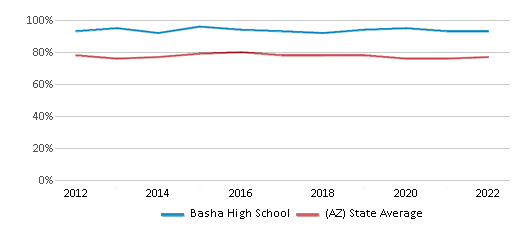
Eligible for Free Lunch
13%
40%
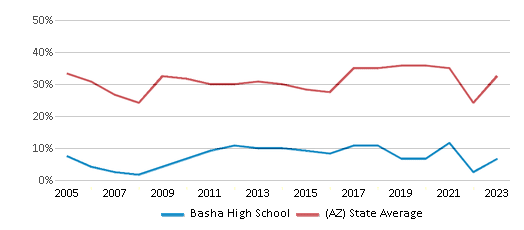
Eligible for Reduced Lunch
2%
10%
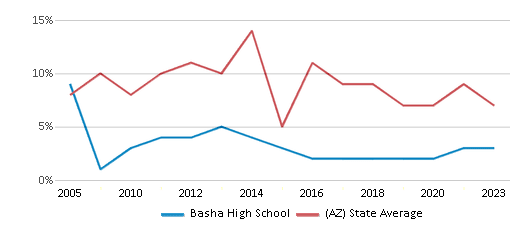
School Statewide Testing
School District Name
Source: National Center for Education Statistics (NCES), AZ Dept. of Education
Profile last updated: 02/09/2025
Frequently Asked Questions
What is Basha High School's ranking?
Basha High School is ranked #56 out of 1,956 schools, which ranks it among the top 5% of public schools in Arizona.
What schools are Basha High School often compared to?
Basha High Schoolis often viewed alongside schools like Perry High School by visitors of our site.
What percent of students have achieved state testing proficiency in math and reading?
75% of students have achieved math proficiency (compared to the 35% AZ state average), while 74% of students have achieved reading proficiency (compared to the 40% AZ state average).
What is the graduation rate of Basha High School?
The graduation rate of Basha High School is 93%, which is higher than the Arizona state average of 77%.
How many students attend Basha High School?
2,892 students attend Basha High School.
What is the racial composition of the student body?
58% of Basha High School students are White, 18% of students are Hispanic, 12% of students are Asian, 6% of students are Two or more races, 5% of students are Black, and 1% of students are American Indian.
What is the student:teacher ratio of Basha High School?
Basha High School has a student ration of 20:1, which is higher than the Arizona state average of 17:1.
What grades does Basha High School offer ?
Basha High School offers enrollment in grades 6-12
What school district is Basha High School part of?
Basha High School is part of Chandler Unified District #80 (4242) School District.
School Calendar
View the Basha High School yearly calendar below. Note key dates such as:
Event
Date
First Day of School for Students
July 16, 2025 (Wednesday)
School Reviews
1 2/15/2021
This school is terrible, the teachers are odd, but there are a few exceptions.
5 4/27/2010
This is a newer school that is not too new to not have any traditions. The teachers are great except for 2 or 3. Many of these teachers have their masters or higher in level of education. This is an A+ school as of this year. This school is among the elite in public schools. Sports are on a high level for all of you jocks and female jocks. Football is has always been a top program in the state since its first year, and Basketball always has a great team, able to contest each year for a state championship. For the female jocks out there, Softball is number one in the state two years running, with two state championships, and competing for a third. Overall I would give this school an A. Sweeps are dumb(.)
Review Basha High School. Reviews should be a few sentences in length. Please include any comments on:
- Quality of academic programs, teachers, and facilities
- Availability of music, art, sports and other extracurricular activities
Recent Articles

What Is A Charter School?
Explore the world of charter schools in this comprehensive guide. Learn about their history, how they operate, and the pros and cons of this educational innovation. Discover key facts about charter schools, including admission policies, demographics, and funding, as well as what to look for when considering a charter school for your child.

10 Reasons Why High School Sports Benefit Students
Discover the 10 compelling reasons why high school sports are beneficial for students. This comprehensive article explores how athletics enhance academic performance, foster personal growth, and develop crucial life skills. From improved fitness and time management to leadership development and community representation, learn why participating in high school sports can be a game-changer for students' overall success and well-being.

February 05, 2025
Understanding the U.S. Department of Education: Structure, Impact, and EvolutionWe explore how the Department of Education shapes American education, from its cabinet-level leadership to its impact on millions of students, written for general audiences seeking clarity on this vital institution.









